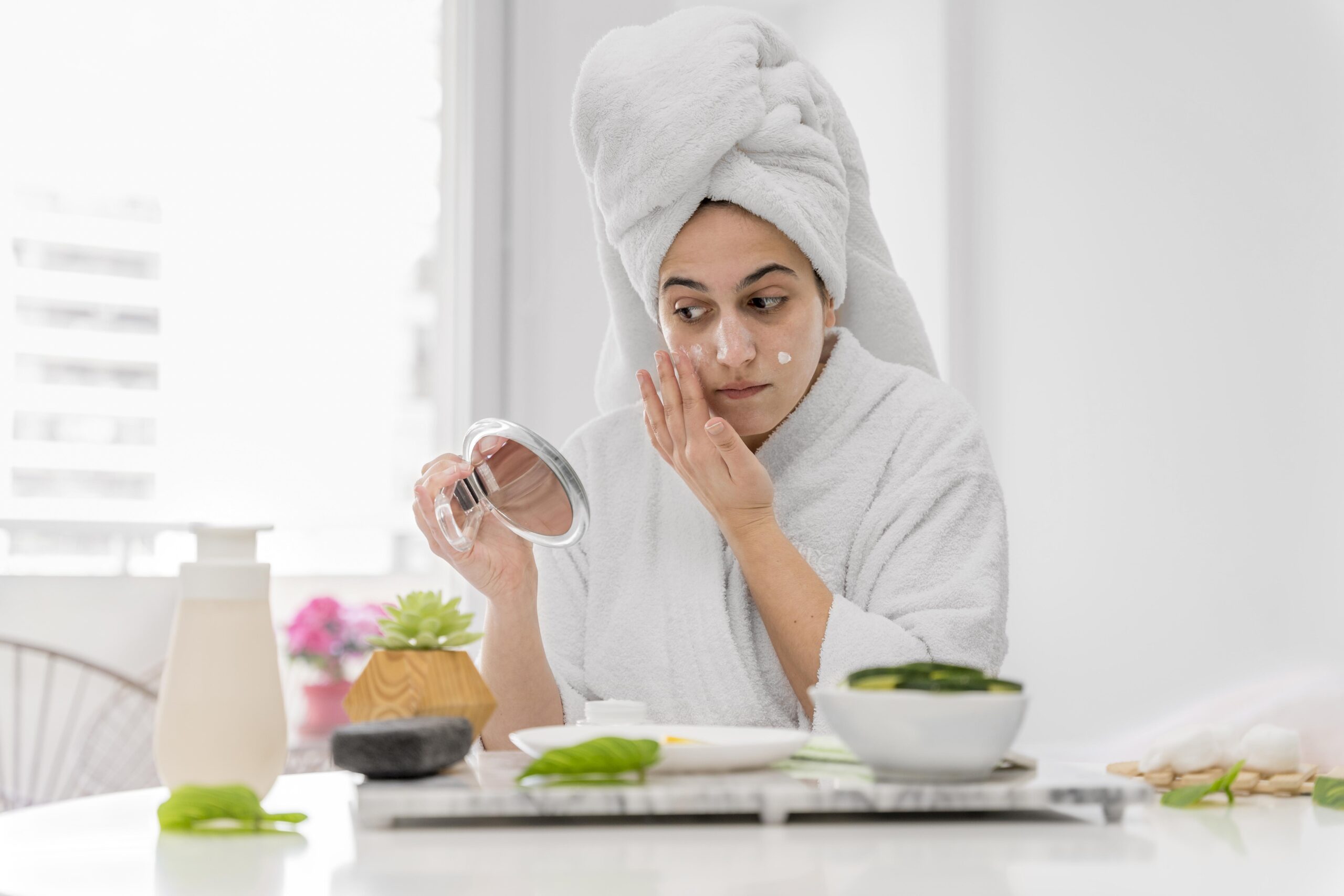Introduction
Sensitive Skin Care Sensitive skin can be a daily challenge, leaving you with redness, irritation, and discomfort. Factors like harsh weather, environmental pollutants, and even the skincare products you use can exacerbate these issues. However, the good news is that with a carefully curated sensitive skincare routine at home, you can soothe your skin and maintain its health and beauty. In this comprehensive guide, we’ll delve into the world of sensitive skin, offering expert advice and practical tips to help you create an effective and gentle skincare routine that you can easily incorporate into your daily life.
Understanding Sensitive Skin – Sensitive Skin Care
Before diving into the specifics of a sensitive skincare routine, it’s essential to understand what sensitive skin is and what causes it. Sensitive skin is characterized by heightened reactivity to various external and internal factors. Common signs of sensitive skin include redness, burning, itching, dryness, and a tendency to develop rashes and breakouts.
Several factors can contribute to sensitive skin, including:
Genetics:
Some people are genetically predisposed to have sensitive skin.
Environmental Factors:
Exposure to harsh weather conditions, pollution, and UV radiation can trigger sensitivity.
Skincare Products:
The use of harsh or incompatible skincare products can worsen skin sensitivity.
Diet:
Poor nutrition and food allergies can also play a role in skin sensitivity.
Hormonal Changes:
Hormonal fluctuations, such as those during pregnancy or menopause, can affect skin sensitivity.
Now that we have a better understanding of sensitive skin, let’s explore how to create an effective and soothing skincare routine at home.
Step 1: Identify Your Triggers for Sensitive Skin Care
The first step in creating a sensitive skincare routine is to identify the specific triggers that exacerbate your skin sensitivity. Keep a journal to track your skin’s reactions to different products, environmental conditions, and dietary changes. This will help you pinpoint the factors that worsen your skin’s condition, allowing you to make informed choices about your skincare routine.
Common triggers for sensitive skin include:
Fragrances: Avoid products with artificial fragrances, as these can be irritating to sensitive skin.
Harsh Ingredients: Look out for ingredients like alcohol, retinoids, and alpha hydroxy acids, which can be too harsh for sensitive skin.
Weather Conditions: Extreme cold or hot weather can exacerbate skin sensitivity, so take precautions when going outdoors.
Allergens: Identify any allergies you may have to certain foods or environmental allergens and try to minimize exposure.
Step 2: Choose Gentle Cleansers for Sensitive Skin Care
Cleansing is a crucial step in any skincare routine, but for those with sensitive skin, it’s essential to choose a gentle cleanser that won’t strip away the skin’s natural oils or cause irritation. Look for a fragrance-free, sulfate-free, and hypoallergenic cleanser that is specifically formulated for sensitive skin.
Here are some tips for cleansing sensitive skin:
Use lukewarm water: Avoid hot water, as it can be drying and exacerbate sensitivity.
Be gentle: Use your fingertips to apply the cleanser in a circular motion, and avoid harsh scrubbing.
Pat dry: Instead of rubbing your face with a towel, gently pat it dry to prevent further irritation.
Step 3: Moisturize Daily
Moisturizing is a crucial step in any skincare routine, and it’s especially important for sensitive skin. A good moisturizer helps to maintain the skin’s natural barrier, preventing moisture loss and reducing the risk of irritation.
When choosing a moisturizer for sensitive skin:
Opt for a fragrance-free and hypoallergenic product.
Look for ingredients like ceramides, hyaluronic acid, and glycerin, which help to hydrate and soothe the skin.
Consider using a moisturizer with SPF during the day to protect your skin from UV radiation.
Step 4: Incorporate a Serum
Serums can provide targeted treatment for specific skin concerns, such as redness or inflammation. When selecting a serum for sensitive skin, look for one that contains soothing ingredients like niacinamide, chamomile extract, or aloe vera.
Here are some tips for using serums with sensitive skin:
Patch test: Before applying a new serum to your entire face, do a patch test on a small area of skin to ensure it doesn’t cause any adverse reactions.
Start slow: Introduce a new serum gradually into your routine to allow your skin to adjust.
Consult a dermatologist: If you’re unsure which serum is suitable for your skin, consider consulting a dermatologist for personalized recommendations.
Step 5: Sunscreen is Non-Negotiable
Sunscreen is a vital step in any skincare routine, but it’s especially important for sensitive skin. UV radiation can worsen skin sensitivity and exacerbate issues like redness and inflammation. Choose a broad-spectrum sunscreen with an SPF of at least 30, and apply it every morning, even on cloudy days.
Tips for selecting sunscreen for sensitive skin:
Look for a physical (mineral) sunscreen with ingredients like zinc oxide or titanium dioxide, as these are less likely to irritate sensitive skin.
Apply sunscreen generously to all exposed areas of skin, including your face, neck, and any other areas that are not covered by clothing.
Reapply sunscreen every two hours, especially if you’re spending time outdoors.
Step 6: Avoid Harsh Exfoliation
Exfoliation can help remove dead skin cells and improve the texture of your skin, but it’s essential to be gentle when exfoliating sensitive skin. Avoid abrasive scrubs and opt for chemical exfoliants like alpha hydroxy acids (AHAs) or beta hydroxy acids (BHAs) in low concentrations.
Here are some exfoliation tips for sensitive skin:
Limit exfoliation to once or twice a week to avoid over-exfoliating, which can irritate sensitive skin.
Start with a lower concentration of exfoliating acids and gradually increase it as your skin builds tolerance.
Always follow exfoliation with a moisturizer to hydrate and soothe the skin.
Step 7: Treat Redness and Inflammation
If your sensitive skin is prone to redness and inflammation, consider incorporating products that target these concerns into your routine. Look for products containing ingredients like green tea extract, licorice root extract, or azelaic acid, which can help reduce redness and soothe the skin.
Tips for treating redness and inflammation:
Use a calming face mask once or twice a week to reduce redness and inflammation.
Consider using a hydrating and soothing overnight mask to provide your skin with extra moisture and care.
Be patient: It may take some time to see noticeable improvements in redness and inflammation, so stick to your routine consistently.
Step 8: Stay Hydrated and Maintain a Healthy Diet
In addition to your skincare routine, maintaining overall skin health is crucial for sensitive skin. Staying hydrated by drinking plenty of water can help keep your skin hydrated from the inside out. Additionally, a balanced diet rich in antioxidants, vitamins, and essential fatty acids can contribute to skin health.
Foods that are beneficial for sensitive skin include:
Fatty fish like salmon and mackerel, are rich in omega-3 fatty acids.
Foods high in antioxidants, such as berries, citrus fruits, and leafy greens.
Foods rich in vitamin E, like almonds, sunflower seeds




[…] diving into the daily hand care at home routine, let’s take a look at some of the common issues that affect our […]